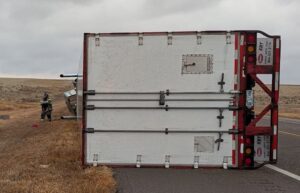WASHINGTON — The future of the U.S. Interstate Highway System is threatened by a persistent and growing backlog of structural and operational deficiencies and by various looming challenges, such as the progress of automated vehicles, developments in electric vehicles, and vulnerabilities due to climate change.
Unless a commitment is made to remedy the system’s deficiencies and prepare for these oncoming challenges, there is a real risk that the nation’s interstates will become increasingly unreliable and congested, far more costly to maintain, less safe, incompatible with evolving technology, and vulnerable to the effects of extreme weather, says a new Congressionally- mandated report from the National Academies of Sciences, Engineering and Medicine.
The report calls for a 20-year “blueprint for action,” which includes creating an “Interstate Highway System Renewal and Modernization Program,” increasing the federal fuel tax to help pay for it and allowing tolls and per-mile-charges on more interstate routes.
“The interstates have long been the backbone of our country’s transportation system, but most of them have exceeded their design lives and in many places are worn and overused,” said Norman Augustine, former chairman and CEO of Lockheed Martin Corp. and chair of the committee that wrote the report. “These aging interstates are highly congested oftentimes and in need of reconstruction. Furthermore, technological advances are offering new opportunities, but they may also undermine a principal source of income for the interstates, namely the tax on fuel. We recommend a course of action that is aggressive and ambitious, but by no means novel. Essentially, we need a reinvigoration of the federal and state partnership that produced the Interstate Highway System in the first place.”
The Dwight D. Eisenhower National System of Interstate and Defense Highways was authorized in 1956 and designed to provide safe and efficient transportation across states. The highways serve as both urban commuter and inter-urban travel corridors, integrate the country’s freight system by connecting to major ports and rail hubs, and are critical to the logistics of national defense.
Constituting about 1 percent of public road mileage, the interstates carry about one-fourth of the nation’s vehicle miles traveled, including about one-half of the miles traveled by heavy trucks.
Moreover, per vehicle mile traveled, interstate highways are the safest roads in the country. Because of their heavy use, however, they still account for more than 5,000 traffic deaths per year. Nevertheless, today they suffer from severe congestion, mainly in urban areas, and in many cases are in need of costly reconstruction.
The committee identified a series of challenges – both long-standing and emerging ones – that confront the future of the interstates. These include rebuilding the system’s pavements, bridges, and other aging assets before they become unserviceable and less safe; adding more traffic capacity and demand management capabilities, especially on congested urban segments; ensuring the system’s coverage keeps pace with changes in the location of the country’s population and economic growth; improving safety as traffic volumes increase; adapting to changing vehicle technologies; adopting new user-based funding mechanisms that will generate the needed reinvestment revenues; and incorporating changing climate conditions into planning and design. For example, more than one-third of interstate bridges have been in service for more than 50 years and will require repair and renewal investments that will add significantly to the major outlays required for rebuilding the system’s original pavement foundation. In addition, large metropolitan areas are expected to continue to account for most of the country’s population growth, yet their interstates have little room to expand locally and are likely to require innovative solutions to accommodate growing travel demand.
The committee noted that advances in technology – ranging from more efficient and faster construction methods and more durable materials to electronic tolling and increasingly connected and automated vehicles – could make the rebuilding of the Interstate Highway System and the allocation of its capacity more manageable, while also furthering the continual goal of increasing the system’s capacity and level of safety.
Recent combined state and federal capital spending on the interstates has been approximately $25 billion annually. To renew and modernize these highways over the next 20 years, $45 billion to $70 billion will be required annually, depending on uncertainties, such as the rate of growth of vehicle miles traveled. The committee noted, however, that these estimates may be low, because they do not include funding required to reconfigure and reconstruct many of the interstates’ 15,000 interchanges or make the system more resilient to the effects of climate change.
To raise the additional new revenue needed for system upgrades, the committee recommended increasing the federal fuel tax in the near term and allowing tolls or per-mile charges on interstate users. Lifting the ban on tolling that applies to most general purpose interstate lanes would provide states and metropolitan areas with more options for raising revenue for their share of RAMP investments and for managing the traffic demand on and operations of interstate segments that offer limited opportunity for physical expansion.
The Trucker News Staff produces engaging content for not only TheTrucker.com, but also The Trucker Newspaper, which has been serving the trucking industry for more than 30 years. With a focus on drivers, the Trucker News Staff aims to provide relevant, objective content pertaining to the trucking segment of the transportation industry. The Trucker News Staff is based in Little Rock, Arkansas.








